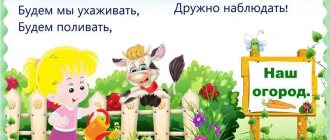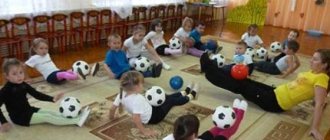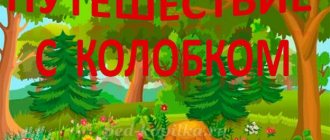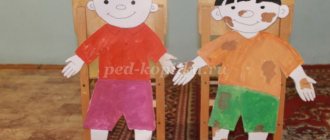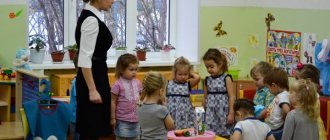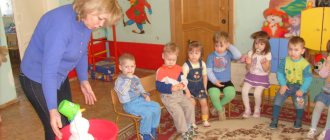Lesson summary for children of the junior group “My hometown is Moscow”
Lesson notes for children of the younger group.
“My hometown is Moscow”
Objectives: - to give children an understanding of the coat of arms, flag, anthem of Russia, and the capital of Russia - Moscow.
— to cultivate respect and love for one’s Motherland and native people.
- activate speech and vocabulary words.
Progress of the lesson
Educator: Guys, today I want to introduce you to our city? But first, tell me, what country do we live in?
Children: Russia.
That’s right, we are all Russians and Russia is our Motherland.
Educator: Russia is a very large country (show on the world map). There are many cities in our country, but there is one most important one. What city is this? What is it called?
Children: Moscow.
Educator: This is Moscow (show on the map). The main city of our country. She is very big and beautiful. There are many streets and buildings in it. There are a lot of poems and songs about Moscow. What is another name for Moscow? (Capital.) How does the capital differ from other cities in the country? Our government is located in the capital, the president works. In the very center is the heart of Moscow - the Kremlin.
Tourists from all over the world come to see the Kremlin: there are many temples and cathedrals on its territory. There are two amazing attractions here - the Tsar Cannon and the Tsar Bell. The Tsar Cannon was cast in bronze at the Moscow Cannon Yard. The cannon was intended to protect the Spassky Gate, but no one was ever fired from it. The Tsar Bell is the largest bell in the world. When the foundry masters smelted this huge bell, there was a fire in the Kremlin. All the Kremlin buildings burned down, and the fire was already approaching the bell. The craftsmen were afraid that the fire might melt the bell, and they began to pour water on it. And due to the temperature difference, a piece broke off from the bell. The Tsar Bell never rang. That's how many interesting things you can see on the territory of the Kremlin. (the entire story is accompanied by a display of sights)
Let's relax a little with you.
Phys. just a minute.
(children walk in a circle) There are many stars in the sky, (hands up, look up)
a lot on earth. (hands down)
The stars on the Kremlin are shining and shining. (hands in front of you, clench and unclench fists)
Guys, there is another place in Moscow that is famous all over the world - this is the square. What is it called?
Children: Red Square.
Educator: “Red” means beautiful, main. In the old days, royal decrees were announced here and people learned the news. Now it hosts celebrations and holidays. Red Square is decorated with St. Basil's Cathedral, or Intercession Cathedral. Many famous people, war heroes, and heroes of our days walked along Red Square.
Educator: Guys, what do you think this is?
Children: Flag and coat of arms of Russia.
Educator: That's right, this is the coat of arms and flag of Russia. The coat of arms is a sign; it depicts an eagle with two heads and raised wings. This image of an eagle signifies the strength and invincibility of Russia.
Children look at the Russian flag.
Educator: What is this?
Children: Flag.
Educator: That's right, this is the flag of Russia. The flag has three stripes of equal width. The white stripe means the color of peace, blue is the color of fidelity, red is the color of strength.
Game "Make it up from parts." (children make up the Russian flag from parts).
Educator: Well done, guys, you completed the task.
Educator: Now let’s listen to the Russian anthem, you need to listen to it while standing. (Russian anthem plays).
Educator: I think that today we learned a lot of new and interesting things about Moscow. We looked at pictures about Moscow, talked about its beautiful places. The Russian people are proud of their Motherland and we are part of Russia, we are Russians.
To consolidate the material presented, children are offered pieces of paper with some of the sights of Moscow drawn schematically (dots). Preschoolers need to connect the dots, add details to the drawing and tell what happened.
Pedagogical project in the second junior group “My city: this street, this is my home”
Transcript
1 Pedagogical project in the second junior group “My city: this street, this is my home” Project passport Type of project: educational - informational, short-term, group. Duration: from year to year Project participants: children of the second junior group “Kids”, teacher, parents of pupils. Integration of educational areas: cognition, communication, physical education, safety, socialization, work, reading fiction, artistic creativity, music. Relevance of the project: Love for the Fatherland begins with love for one’s small Motherland and the place where a person was born. The goal of the project: to expand knowledge about your hometown and its attractions. Project objectives: 1. To form an idea of the Motherland based on familiarization with the immediate environment. 2. Introduce the basic rules of safe road traffic as a pedestrian and passenger. 3. To introduce children to the street, its features, freight and passenger transport. 4. Arouse cognitive interest, a desire to learn new things about your hometown. 5. Cultivate love for your hometown Borovichi, pride for your small Motherland. Work with parents: 1. Conversation on the topic “Patriotic education in the family.” 2. Joint productive activity of children and parents: “Houses and buildings.” 3. Exhibition of joint works “The House Where I Live”. 4. Conversation between parents and children about their city, home address, explanation of the rules of conduct on city streets and in public transport. Product of the project activity: 1. Panel “This is a street, next to it is a river” 2. Collective work on the art activity “Transport”. 3. Presentation of the project.
2 Expected result: 1. Increasing the level of children’s knowledge about their city, the street and its related concepts, as well as knowledge of transport, rules of behavior on city roads, in public transport. 2. Activating children’s interests in their small homeland and their city. Stages of the project: Preparatory stage: - selection of illustrations, paintings, recordings on the topic of the project; — selection of children's literature on the subject of the project; — selection of photographs of city views; — preparation of material for visual arts. Project content: - conduct cognitive cycle classes to familiarize yourself with the environment; — organize creative activities for children: Russian folk games, drawing, appliqué, modeling; - involve children and parents in the production of houses and buildings to decorate the street layout. Project implementation: Teacher activities 1. Replenishing the center of the book with photographs and illustrations of landscapes and attractions of our city. 2. Design of the photo album “My Favorite City”. 3. Develop a series of conversations and GCD on the topic of the project. 4. Making a card index for monitoring transport. 5. Design of an album of poems about the city of Borovichi. Children's activities 1. Reading fiction about transport, the city: poems, riddles. 2. Examination of illustrations “Passenger transport”, “Freight transport”, “Buildings”. 3. Artistic and productive activity: Drawing “House with a fence”, “Here is a car coming”, panel “This is a street, next to it is a river”. Application “Windows for the home”. Modeling “Bricks”, “Cars”. 4. Finger gymnastics. Parents' activities 1. Conducting conversations with children. 2. Help in replenishing the center of the book with illustrations and
3 photos. 3. Drawing “The house where I live.” 4. Making models of buildings and houses from waste material. 5. Walk with children around the city, pay attention to the beauty of the city landscape and the architecture of the buildings. Plan of work with children: 1 week Conversations: “What kinds of cars are there”; "We're going on the bus"; invitation to the driver's dad's group (story about the work of a truck driver). Examination of illustrations from the “Transport” series (freight, passenger); viewing a map of the city (note that all the streets of the city, the Msta River, which divides the city into two parts, are marked on the map); Observations: targeted walk to the truck, observation of the bus (where it stops, rules of behavior in public transport), Reading fiction: B. Zakhoder “Builders”, “Chauffeur”; S. Mikhalkov “A car was walking down the street”; V. Berestov “This is me going running” Artistically productive activity: designing “Garage and gates for transport”, drawing “House with a fence”, sculpting “Car”, applique “Bus for children”. Physical education Finger gymnastics “I walked alone”, “Home”. Role-playing games: “Gas Station”, “Car Repair”. D/games: “Buy the right part for the car”, “Say it correctly”, “Fix the car”, “Transport” (orientation in color, shape of objects, classification of objects), “Stand where I say.” Singing: “The car, the car is moving, it’s buzzing.” Week 2 Conversations: “What kind of houses are there” (examination of a multi-storey building: entrance, stairs, mailboxes, doors; and a private house: fence, yard, porch, garden; pay attention to the differences), “City streets”, “Purpose of a traffic light with using a poster"; “The house where I live” (name of the city, street). Examination of photographs “Sights of the city of Borovichi (Belelyubsky arched bridge” across the Msta River; railway station where trains arrive); looking at the poster “On Our Street”.
4 Observations: target walk “We get to know the street”; monitoring traffic on the roads, reading fiction: N. Kalinina “How the guys crossed the street”; S. Mikhalkov “My Street”; S. Marshak “For pedestrians.” Artistically productive activities: building high and low houses, drawing, sculpting “Bricks”, applique “Traffic Light”, laying out city streets from blanks, painting silhouettes of houses and other city buildings, creating the panel “This is our street”. Physical education Finger gymnastics “Man on a walk”, “Our walk”. Role-playing games: “We are traveling on a bus”, “Chauffeurs”. D/games: “The third wheel”, “Where to put what?”, “Assemble a traffic light”, “Right - wrong”, “Make a whole”, “Is it possible or not.” Activities: 1. Excursion “Streets of our city” 2. Exhibition of joint works of children and parents “The House in which I Live”. 3. Design of a street model (joint work of the teacher and children to make a model of the roadway, sidewalk and traffic light; children and parents to make models of houses and buildings from waste material) As a result of the project: Children will increase their level of knowledge about their city and its objects and attractions, about the variety of types of transport and means of transport. There will be an interest in your small homeland and your city. Knowledge about the street and its features, knowledge of the rules of behavior on city roads and in public transport will be formed. Conclusion Love for the Fatherland begins with love for one’s small homeland and the place where a person was born. Thus, it is possible to develop love for the Motherland, for one’s hometown, for one’s native nature only at a young age. Summary of educational activities for children 3-4 years old on the topic: “On the streets of the city” Program content: to give children an idea of the street and its features, the purpose of a pedestrian crossing, a traffic light; develop interest in various types of games, the ability to observe and draw simple conclusions; develop the ability to lead correctly
5 yourself on the street; promote the inculcation of a culture of safe behavior on the road through game images. Integration of educational areas: cognition, socialization, communication, physical education, health, safety, reading fiction. Materials and equipment: model of a roadway with a pedestrian crossing (“zebra”), strips of brown paper (sidewalks), models of houses and buildings, model of a traffic light, steering wheel. Previous work: reading fiction by S. Mikhalkov “My Street”, S. Volkov “About the rules of the road: pedestrians and cars”; examination of illustrations and photographs “Streets of our city”, targeted walks along the nearest streets (examination of traffic lights), d/game “Our friend the traffic light”, buildings made from building material “This is a street” NOD progress: Educator: “Children, we live with you in the city of Borovichi. There are many streets, different houses and buildings in our city. There are a lot of cars rushing along the roads at high speed, and pedestrians are crossing the road.” What cars did you see on the road? That's right, trucks (they transport goods), cars, buses (they transport people). - What do they call the people who travel on the bus? (passengers). And in passenger transport you have to buy a ticket, go through and sit in an empty seat, and follow the rules of behavior. Transport helps us quickly get where we need to go. There is a knock on the door, the teacher brings in a boy's doll. - This is Toropyzhka. They call him that because he is always in a hurry. He was in a hurry to visit us, but on the way he got into an unpleasant situation. - Hello Toropyzhka, what happened to you? “I wanted to bring gifts to the guys, but there are so many of them that I don’t know how to deliver them.” - Let's, guys, tell Toropyzhka how you can bring all the gifts at once. (by truck). Toropyzhka: — What kind of cargo can trucks transport? (Furniture, bricks, boards, sand, food). — Who drives passenger and freight transport? (Drivers). — Cars are our assistants, but without a driver they cannot work. — Let’s play the game “Transport the cargo.” (Children, at a signal, turn into any truck and move around the group, without colliding, carefully transporting their cargo. After the game, the children tell what color trucks they were and what cargo they transported). Toropyzhka: - And now I know how to bring gifts. I'll load them into the truck.
6 - Toropyzhka, do you remember how to get to us? After all, there are a lot of streets in the city and they have different names: there is Pushkinskaya, Gogol, Podbelsky (Toropyzhka shrugs). Our kindergarten is located on Botanicheskaya Street. Toropyzhka: “You all say a street, but what is a street?” - Let's tell you guys and show you what a street is. And you, Toropyzhka, look and remember. — This is a road, it’s called a roadway (children put a model of the road on the floor), cars drive along it towards each other, and this is a sidewalk (they lay out paths along the road) people walk along it. Tell me, what do you call people walking down the street? (Pedestrians). They walk along the sidewalk at a calm pace, sticking to the right side so as not to disturb each other. All that remains is to arrange the houses and buildings (children arrange models of houses and small cars). This is how our street turned out. Toropyzhka: - Hurray, I can cross the street. (Toropyzhka runs across the road). “Toropyzhka, you can’t cross the road like that, you might get hit by a car.” Now the children will tell you and show you how to cross the road correctly. And you can only cross the road in a special place. Reading an excerpt from S. Volkov’s poem “About the rules of the road. How to cross the road." Here is the usual transition. Everyone, go to your store. People walk along it. He sees that the street intersects with the road, There is a special marking here, And this intersection is aptly called a “Zebra”! It's called a crossroads! White stripes here So that near the intersection They lead across the street! You crossed the road, Pedestrian crossing sign, All colors at the traffic light Where is the pedestrian on the zebra crossing, You need to remember well! You find a red light on the street - and cross under it! No way for pedestrians! Approach the zebra crossing and wait, Yellow means wait, Don’t rush forward: But the green light, go! Look to the left, if there are no cars, go. You look to the right, there are no cars. While reading the poem, children perform actions in accordance with the text. - Now do you understand, Toropyzhka, how to cross the road correctly? (Yes, thanks guys)
7 — Our friend traffic light came to visit us. Let's show Toropyzhka what kind of fires he lights. D/game “Our friend the traffic light” (The traffic light is not working, we need to fix it; repeat what each color means). Toropyzhka: - Thank you guys, you taught me a lot, I will be very attentive on the street, but it’s time for me to get gifts. I'll bring them by truck. Goodbye. - Goodbye Toropyzhka, come and visit us.
